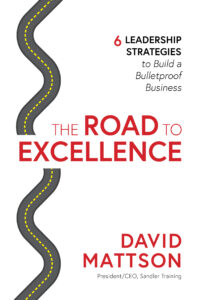How to Achieve Organizational Excellence
Excellence.
It’s the focus of every leader. It’s the aspiration of those who seek to make a mark.
How to achieve organizational excellence is the subject of a new book by David Mattson, CEO of Sandler Training. THE ROAD TO EXCELLENCE: 6 Leadership Strategies To Build A Bulletproof Business is the result of his research and experience as a CEO of a global organization. I asked him to share some of his leadership insights as well as some blind spots that can catch business leaders off guard with potentially disastrous consequences.
Leadership Blind Spots
The first part of your book spotlights the blind spots that many have in building a culture of excellence. Of these 14, what blind spots do you see leaders making most often when it comes to leadership excellence?
The most common mistake – and it seems to be universal across all industries – is the failure to make recruiting the very best people an ongoing, continuous priority. Effective leaders are always in recruiting mode, not just when an opening appears. They build up a bench of talent, so that when there’s an unexpected departure by a key person, there’s no crisis that threatens the entire organization. If you look at the top-performing companies that dominate, you almost always find that they’re the ones that have made recruiting the very best people an ongoing organizational priority. You are always, always looking for the best talent.
Know the 6 P’s
Let’s talk briefly about the 6 P’s. Planning. When a leader does this well, what does it look like?
Effective leaders think about where the business can and should be over the next three to five years. They think about the markets and the direction they’re headed in.
They think about where the company should focus their attention, about what they want to do – in short, they think in the future tense about each and every part of the business. That means they create a plan of action, complete with benchmarks. They look at the roadmap and identify the best possible route toward their future goal, and they get key people in their organization to participate in the discussion so that there is buy-in on the journey. They don’t let their present situation hold them back. They take off the blinders.
Their biggest challenge may be communicating the plan, because you need to continually communicate the future goals and the plans to get there in multiple modalities. Just sending out an email about the plan isn’t enough. You need face time, you need podcasts, you need video, you need everything … and you need it over and over again.
How about the second P, Positions? Organizational structure and required skill sets for each position are important. Given the speed of change, how often is this assessment done for optimal results?
This part focuses on the organizational chart. The idea is to sit down and consciously design what your company will look like when it’s aligned to the key goals you’re pursuing. This is an objective process, something that you separate from any emotional connections there may be with individual team members. You say, “Here is what the company needs to look like in order to achieve X … now, what needs to change, and what positions do I need to fill?”
Again, it’s ongoing. You should create an ideal SEARCH (Skills, Experience, Attitude, Results, Cognitive Traits, and Habits) template for each position, and then recruit to that template. And you should create a customized onboarding program for each position. That seems like a lot of work, but it’s actually a net time savings, because you’re far more likely to get the right person in the right position.
It’s important to remember that this is something you need to do continually. Major change in your company can happen before you are done going through all 6 P’s, which means you may need to adjust the org chart. Basically, any time you adjust your plan, you should expect to adjust the positions that support it.
The Importance of People
Let’s move on to the next P, People. What do “excellence leaders” do that makes them stand out in terms of hiring and retaining the best people?
Excellence leaders hire to a specific, clearly defined role, and with specific KPIs in mind. They are very clear on the Skills, Experience and Results that the person doing the job would need in order to succeed. This knowledge gives them the ability to make the best hire possible.
Beyond that, some of the important best practices here are never to hire on gut instinct (it’s wrong too often), to incorporate other people in the interview process, to onboard properly, to set clear expectations, never to “blue sky” the job and create false hopes, and to look for ways to tie the individual’s unique personal goals to the goals of the company. Again, many managers think they don’t have time for that last one, but it’s a definite time-saver over the long term.
The next P is Processes. In your book, you point out that great leaders have processes for most everything. Some organizations grow to a point where process chokes progress. How do you know you have the right balance?
People usually cringe when they hear the word “process.” I don’t believe anyone needs to be smothered in process. When a process loses sight of the intent that led to its creation, that’s when it’s time to re-evaluate. Really, this is a cultural issue. You want people to have a sense of “how we do things here,” and to be ready to share and document best practices that others can follow. This is more of a playbook approach than a “death by paperwork” approach.
Some companies make process more of a compliance issue; that’s not what I’m talking about. I’m talking about checking to see how your organization can improve by asking people – and particularly new people – about what areas they need more explanation and support on in order to do a good job.
I’ve noticed something interesting about this. If you say, “Make sure you have a good playbook,” as opposed to “Make sure you have a process,” most people will buy into the idea of a playbook. They leap at the chance to capitalize on existing best practices and not have to figure out everything on their own.
The next P is Performetrics. I like the term. Why is this so critically important?
When it comes to execution in all the different parts of the business, you need to have a view into what is both important and measurable. That’s true at the organizational scale, where you track the right KPIs to see how the business as a whole is doing, and it’s true at the individual scale, where you aim to give people a performance metric they have personal control over that connects to their own personal performance target.
The various parts of your plan should all have metrics that allow you to determine whether you are on track – and, if you’re not, that provide the right type of data so you and your team can determine what needs to happen next. The keys are to check often, to adjust, and to share what you’ve learned about how you’re doing with the rest of the team.
Give people a clear sense of WHY a given metric is important, both on the personal level and on the team level. Once people understand what is important, and why it makes sense to measure that, they’re more likely to be engaged, and they’re more likely to succeed.
Passion. That’s the last P. How do the best leaders ensure that everyone shares it?
 To sustain passion throughout the organization, the leader needs to have a deep personal conviction that the path the organization follows truly is the right path — and needs to be comfortable sharing exactly why that is so — in terms that will resonate with others. The leader must be prepared to continually communicate where the company is going and why.
To sustain passion throughout the organization, the leader needs to have a deep personal conviction that the path the organization follows truly is the right path — and needs to be comfortable sharing exactly why that is so — in terms that will resonate with others. The leader must be prepared to continually communicate where the company is going and why.
The leader needs to be congruent – meaning the words the leader uses in the workplace and the actions undertaken within the working relationships always need to match up.
The leader also has to be willing to give coaching and support to emerging leaders, because developing people is a critical organizational priority.
If those pieces are in place, and if the leader is willing to commit to the 6 P’s process on a continuous basis, then the leader’s passion for the plan will become contagious.
For more information, see THE ROAD TO EXCELLENCE: 6 Leadership Strategies To Build A Bulletproof Business.

